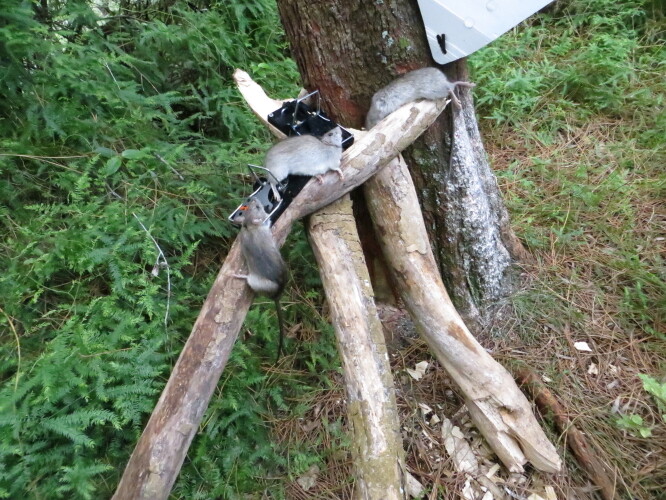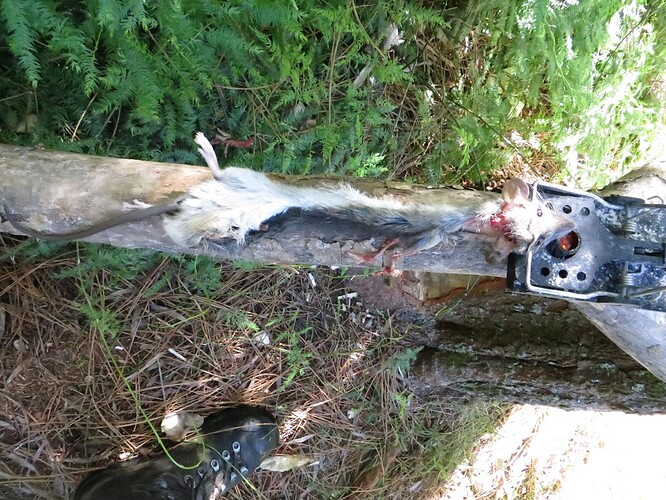Looking for advice. What does everyone do with their dead rats on a line in the bush (not backyard) Bury it? Chuck it to the side? Put in bag and take home? thanks
I can’t speak for DOC, but in my experience they rot down very quickly, so leave them in the bush. An advantage of leaving them is that, when they are fresh, they act as an attractant to other rats and stoats.
Just my opinion.
Thanks thats been my method so far
The smell of rotting flesh deters mustelids, so I dispose of my kills off-site. I use a plastic container with a secure lid to limit the smell, and I hose out the container. I dump the carcasses at a small spot in some scrub, rather than putting them in the garbage, but this isn’t an option for everybody.
You could bury carcasses, but it would take more time and energy than simply putting them in a container, but it depends on how many traps you’re operating. Chucking carcasses might not be a problem if there are plenty of scavengers around, but I’m not willing to risk deterring stoats if rats are left to rot.
Cheers.
Compost them on site if you have enough leaf matter. Sweep up enough up with your boots to cover the kill - say a half a foot of material - the more you add the less smell and the faster the worm action. Let the bugs do their work and return the nutrients to the trees the rats stole them from 
… that’s what I do when and where I can. Possums close to home used to end up on the fruit trees buried in lots of mulch. We’ve run out of possums in recent times though, rabbits however are a different tale.
When I catch rats I toss them nearby. When I catch possums I take them home and put them in a big compost bin that I’ve nicknamed the “com-poss”. Birds love scratching at the ground around it and eating the maggots that crawl out. Someone also suggested to be that I make a cat proof hawk table and leave them for the hawks. We have a lot of feral cats so we don’t leave the possums out otherwise it attracts them.
We don’t catch a lot of rats, more mice and mustelids, and sometimes possums. If they are small or very rotten, we toss them out on the line. We work in a wetland so where possible we toss them in water for the tuna to feed on. If they are together enough to cart back to base, we remove the feet (sharp claws) and have a regular tuna feeding spot where we toss them in.
If you’re in a coastal area, or more specifically an estuary, you can feed them to the mangrove crabs. Given the damage that possums do to native stuff I figured they could give back a little after they’ve died. The corpses are usually picked clean within a day or two.
I don’t waste good fresh catch.
If fresh, I gut the rat or stoat (takes 5 seconds, hold by tail, slice with sharp knife, flip guts out on knife so hands keep away from risk of disease). And or use gloves. From caught stoats the liver and kidneys are great inside trap entrance or in bait holder (i have also created wire netting simple bait holders that keep bait suspended so air flow spreads scent and animal can still easily see it).
Put guts near trap to attract more catch. Then rub carcass over trap inside and out.
If winter and temperatures under 3° I leave carcass in bait area of trap for the week. Definitely increases catch.
Often tie it to a length of bailing twine and drag along trapline creating a scent trail. Sometimes use gloves and rub it all over each trap too. This gets other animals excited and they feel more safe entering a box.
DOC tell me quite a lot of my traps are among best catchers on mountain so it’s working.
Most of them are cannibals and eat each other.
I leave the dead one beside the trap or on the box – a great attractant for his mates or another predator. I never touch them without gloves – they carry some awful diseases and don’t let your dog touch them.
I had a site with a hungry predator – I placed some extra traps on ramps, stacked up the victims and finally got the cannibal – a dark rat that was still alive.

Carcasses are one of the best rat and mustelid lures, in my experience, but their condition makes a big difference, of course. In hot weather, I don’t leave them inside my DOC tunnels for very long, because the smell can deter stoats and weasels. Brown/Norway rats and hedgehogs are the least fussy when it comes to scavenging older carcasses.
Tongs are an excellent way to handle carcasses, BTW.


